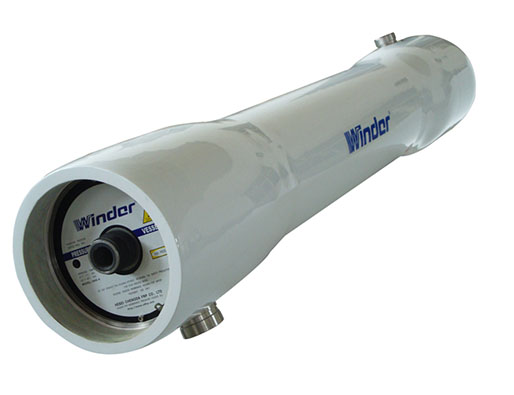When the reverse osmosis membrane pressure vessels are in the water pretreatment process, the membrane shell fittings have a protective effect on the membrane technology, and the reverse osmosis process has made great progress in the production of pure water. The barrel body, head, and slot of the reverse osmosis membrane shell have undergone strict layup design and optimized calculation details to ensure structural safety and ensure the safety and stability of the water treatment system under the pretreatment pressure for a long time.
The reverse osmosis membrane housings components are used as accessories to protect the reverse osmosis membrane. The types can be divided into the seam and seamless. This equipment is made of stainless steel. The end caps are made of ABS and stainless steel and are sealed with silicone O-rings, which have high sealing performance and long service life. The water inlet and outlet have an end and side inlets. The membrane shell is divided into card sleeve type, flange type, and built-in type. The shell is made of 304 seamless stainless steel tube. It has good sealing performance, high pressure resistance, no aging, and easy installation and cleaning of the membrane.
The quality of the reverse osmosis membrane shell in the water pretreatment directly affects the service life of the reverse osmosis membrane.
Regardless of whether the water quality of the feedwater is surface water or groundwater, it will contain some organic and inorganic pollutants. If these pollutants are directly fed into the reverse osmosis system for operation without pretreatment, those pollutants and suspended solids will remain in the membrane. On the surface, the flow channel is blocked, the pressure of the membrane element increases, the water production, and the salt rejection rate decrease, and even serious consequences such as membrane fouling or membrane damage are caused.
At the same time, the FRP membrane shell is very likely to pollute the membrane due to the thickness of the water supply screen when the concentration of organic matter and alternate and suspended matter in the feed water is very high. Before discussing this issue, we must first understand how to protect the membrane shell, so as to ensure that the membrane elements cannot cause pollution.

Reverse Osmosis Membrane Housings
In short, the most common type of water pretreatment of FRP pressure vessels for large RO systems is membrane element contamination. When it comes to membrane element contamination, one of the most important components has to be mentioned, that is The reverse osmosis membrane shell, which plays a role of pressure resistance and protection in the entire system.
What are the physical properties of the FRP membrane shell? The following is a detailed summary of everyone:
1. Using special technology
According to the comprehensive design of the product characteristics, the use of advanced processing technology improves the smoothness, smoothness, and brightness of the inner wall of the product.
2. Multiple openings
In view of the diversified docking methods between containers, multi-opening customization is realized to ensure convenience and safety in the installation process.
3. Embedded embedded ring
The integrated embedded ring made of stainless steel or glass fiber reinforced plastic is pre-embedded to ensure that the fiber structure of the shell is not mechanically damaged, and the installation of the head assembly is flat and sealed and the assembly is simple and safe.
4. Outer surface technology
The product adopts the car paint process, which has high brightness and super strong paint film adhesion on the outer surface of the product.
5. Safety design of inlet/outlet
The water inlet/outlet adopts the "L" type design, which makes the product have the advantages of no penetration in low and high areas and high pressure resistance.